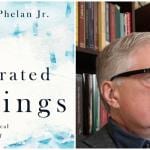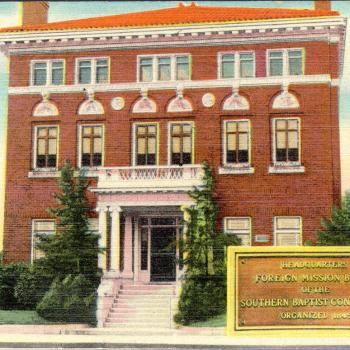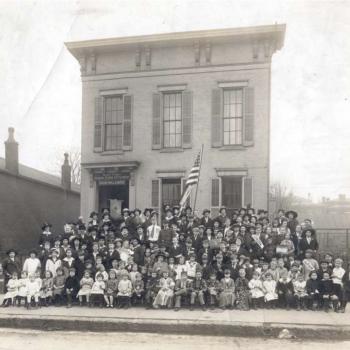When modern people read about Christian history, most find it very hard indeed to understand why bygone eras cared so much about religious issues – about things that we might dismiss as “just theological.” Were such things really worth the cost of anyone’s life or liberty? We need to understand why some things that seem so innocuous to us today were so explosive in other eras. The whole story also has a strong contemporary relevance, for understanding modern religious change and conflict worldwide.
Here is a historical example that has long been dear to me, and I will suggest why it still speaks today. One of the great memorials of Baptist history, and of British religious history, is the Ilston Church Book, the records of a pioneering Baptist church meeting in the Gower region, near Swansea, in the Welsh county of Glamorgan, from 1649 through 1660. The Ilston congregation left for America in 1663, where they founded the town of Swansea, Mass. They took the precious book with them. It was recovered in the twentieth century, after a long search that included delving in the library of Brown University in the 1920s. That adds a special frisson for me, as that was the original of H. P. Lovecraft’s Miskatonic University, where dark horrors were always being discovered in that library in that very decade. But back to Baptists…
To put this in context, the period of the church’s most expansive growth from 1649 through 1653 was probably the most radical era of British history, coming right after the execution of the king, and the overthrow of most of the great aristocratic families in the Civil Wars. In a social order that accepted the dominance of the Church and the landowner, people had fresh memories of having plundered the manor-house and the vicarage, of seeing the gentleman and the parson abase themselves to parliamentary committees to regain a subsistence. Apocalyptic and messianic expectations reached boiling point.
The Church Book is a wonderful resource in all sorts of ways, and not just in its strictly religious content. The very first disciplinary case recorded is a classic instance of what we might call serial sexual harassment. John Austin (member #24) had tried to “force” a maid serving in his house, which led her to leave the job, and he refused to pay her quarter’s wages unless she took him to court. There were other sins, including trying to “commit uncleanness” with another maid, but this first incident was the focus. It is instructive that the church took this behavior so seriously to have him “cast out.”
But even against this background, let me offer what contemporaries would have found the most shocking section of the Book, which is its simple list of members. It begins with the founders of 1649:
Thomas Proud of Llandewi
Jane Lloyd of Paviland
Elizabeth Proud of Llandewi
Margaret Davies of Ilston
And so on with dozens of believers from parishes scattered around the region, from Bishopston, Llanmadoc, Loughor, Llanrhidian, Llangyfelach, Margam, Aberafan – 150 individuals or so by 1653, and another hundred over the following decade. Beyond the many different parishes – perhaps twenty or so, most drawn from a radius of thirty miles – there are members from at least two neighboring counties. The gender balance, incidentally, is fairly evenly split. People joined the church by a new act of adult baptism.
So why on earth do I say this is shocking? Was it a theological point about concepts of baptism? Well, sure, but there was something much more fundamental, which is where those people were coming from, and all those parishes.
Think of the English or Welsh world as it would have existed in 1640, and which would more or less have been paralleled in most European nations. Within that world, if you were an ordinary person, just who were you? Well, first and foremost you were a member of a parish, which you were entered by an act of baptism. You were a member of the parish of (say) St. John’s, Cardiff. That decided your religious identity, of course, but also who you were civilly and politically.
The parish minister had his say over issues of belief, but secular worthies also mattered enormously. They paid rates, which were used to provide the social welfare system. From 1601, the English Poor Law was administered through the parish. That is one reason why secular and religious officials (like the infamous beadles) were so viciously keen on matters of chastity: they did not want illegitimate children they would have to support. No line whatever separated church and state, secular and sacred. Abandoning one meant abandoning both.
Beyond the parish, there were certainly higher levels of government and administration. The county was a key unit of justice, administration, and military organization. Quarter Sessions, the county Bench and lieutenancy, the Grand Jury – all were county events and institutions, deciding issues central to the life of the landed community, clergy and burgesses, and to the making of policies that affected virtually everyone within the shire. Somewhere in the stratosphere beyond that, there was the king and his court, but very little of what went on there affected ordinary people. The parish was almost all, with the county beyond that. So crucial was the parish that its exact boundaries mattered immensely. Every year parishioners marched around the exact boundaries, noting every key tree and rock, and duly beating children at those key points so they would never forget the landmarks. They literally beat the bounds.
The parish was religious society, and civil society, and the social welfare net, and the enforcer of morality, and the foundation of the ritual year, with all its feasts and fasts … and so many other things. You knew exactly who anyone was because of their parish. Everything of note happened in the parish church or the churchyard. Well into the eighteenth century, that ritual and social life followed customs and pastimes that Puritans denounced as irredeemably pagan and superstitious, although in fact they mainly drew on late medieval Catholic piety.
Now let’s go back to the Ilston Church Book. To take an example at random, on April 15th 1651, Elizabeth Bevan of Margam was baptized into the Ilston church, as its 72nd member. Margam was a parish, gathered around a fine church on the site of an old monastery. Elizabeth was a parishioner of that place, with all the connections and duties and networks into which she had been born, and admitted formally through baptism as a child. She was now rejecting that sacrament of baptism, but also throwing off all those ties and obligations by joining a new church. By modern perceptions, Ilston was and is physically very close to Margam, around 25 miles, but by the mental maps of the time, it was utterly distant, a whole different world, as measured for instance by social networks, economic ties, and marriage patterns.
Throughout modern history, rejecting or betraying your country has been a dramatic act that carries many consequences. But imagine doing something that at once rejected your hierarchies, your social networks, your civil society, your history, and your whole sacred geography. Instead, you voluntarily join a whole alternative society. Is that radical enough for you? And when people actually joined from other counties, from Devonshire or Breconshire… the mind boggles. Members of the Ilston church held meetings in their home areas, where they became a kind of alternative religious world to the surviving parishes. In turn, that Ilston church cooperated with other Baptist churches and networks which were equally independent of the old parish structures.
This might seem obvious, but those official parishes did not permit formal religious diversity. Everyone was supposed to follow the same approved ways of belief and practice. The notion of a parallel or separate church entity staggered and appalled all but the most radical.
Put another way, the Reformation tried to change the way people worshiped in the churches and parishes that formed part of the approved state and national church. The Radical Reformation made the critical next step, to rejecting those structures entirely. Baptists were at the forefront of that critical move. But as conservatives argued, once that river had been crossed, Christian orthodoxy itself faced real challenges. Baptist churches throughout the British Isles were soon split by schisms over far more radical doctrines, associated with Quakers, Seekers, and even some outright atheists.
There are plenty of modern analogies to the kind of revolutionary defection committed by Elizabeth Bevan and her friends. It is what ordinary people do in Latin America when they leave their villages and Catholic parishes and move to the cities, where they join fervent Pentecostal churches. The old faith based on symbol and ritual action is replaced by a new emphasis on literacy and the sacred text. It is rather what North African Muslim migrants do when they come to France, and forsake their old ritual world of sheikhs, shrines, and Sufi orders. Faith is suddenly and painfully deterritorialized. Those believers struggle to find some new basis for faith, and some find it in rigid Islamist groups and movements. But whatever new believers have lost through cultural change, they feel that they have gained much. However poor in material things, they know in their hearts that they are following a pristine form of apostolic faith.
As Jews had discovered millennia before, when you lose your home territory, voluntarily or otherwise, scriptures become a mobile sacred homeland. Those texts can also supplant all worldly powers and authorities.
But older societies and elites are not necessarily too forgiving about such innovations and the defections they cause. I offer an example from a piece I wrote a couple of years ago about the Maya peoples of Central America:
Maya faith also encountered something like a Reformation. In its Pentecostal forms, evangelical Protestantism spread rapidly through the region from the 1980s onward, overwhelmingly in Guatemala, more haltingly in southern Mexico. The new model of faith proved deeply divisive. Traditional elites had no concerns about ordinary people espousing new theologies, but they were alarmed when evangélico converts refusing to participate in the fiestas, processions, and ritual celebrations that were the life-blood of the people. Those converts had no wish to acknowledge Catholic saints, and moreover abstained from the alcohol that was so integral to the festivities, leading them to withdrew from the customary life of the community. Much as in sixteenth century Europe, the issue of popular rituals drove bloody conflicts within communities that had existed harmoniously for centuries.
When you see Baptists or Quakers or Anabaptists or religious dissidents being persecuted in early modern Europe, by all means look for theological explanation. But never underestimate the enormous political and social and civil implications of what those new churches were trying to do. And what their successors are trying to accomplish today.
B. G. Owens did a fine edition of The Ilston Book (Aberystwyth: National Library of Wales, 1996). I described the doctrinal conflicts rending the Baptist churches in an article entitled “Infidels, Demons, Witches, and Quakers: The Affair of Colonel Bowen,” in Fides et Historia 49(2)(2017): 1-15
Full Disclosure: I have relatives in the Ilston church list. They would be tickled to know that I teach at Baylor University.













